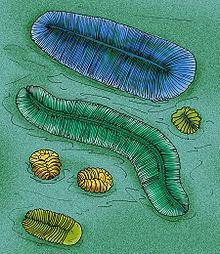Rank Phylum | ||
 | ||
Phylum †Proarticulata Fedonkin, 1985 Similar | ||
Proarticulata
Proarticulata is an extinct phylum of very early, superficially bilaterally symmetrical animals known from fossils found in the Ediacaran (Vendian) marine deposits, and dates to approximately 558 to 555 million years ago. The name from Greek προ (pro-) = "before" and Articulata, i.e. prior to animals with true segmentation such as annelids and arthropods. This phylum was established by Mikhail A. Fedonkin in 1985 for such animals as Dickinsonia, Vendia, Onega, Praecambridium and currently many other Proarticulata are described (see list).
Contents
- Proarticulata
- Vendiamorpha
- Cephalozoa preliminary name
- Dipleurozoa
- Proarticulata Incertae sedis
- Body fossils
- Trace fossils
- References
The transverse articulation (division) of the Proarticulata body into isomers is distinct from the transverse articulation segments in annelids and arthropods, as their individual isomers occupy only half the width of their bodies, and are organized in an alternating pattern along the longitudinal axis of their bodies. In other words, one side is not the direct mirror image of its opposite (chirality). Opposite isomers of left and right side are located with displacement of half of their width. This phenomenon is described as the symmetry of gliding reflection.
Vendiamorpha
The body is completely segmented, with all isomers curved towards the posterior, and the first isomer is normally much larger than the rest. The first two isomers at the anterior dorsal end are partly fused. (e.g., Vendia, Paravendia and Karakhtia).
Cephalozoa (preliminary name)
These proarticulatans demonstrate incomplete segmentation, as the anterior zone is free of isomers, often making a "hairband" like appearance. (example cephalozoans include Yorgia, Praecambridium, Andiva, Archaeaspinus, Ivovicia, Spriggina, Marywadea and Cyanorus. Some cephalozoans from the family Yorgiidae demonstrate pronounced asymmetry of left and right parts of the body. For instance, Yorgia’s initial right isomer is the only one which spreads far towards the left side of the body. Archaeaspinus has an unpaired anterior lobe confined by the furrow to the left side only.
Dipleurozoa
The dipleurozoan body is subradial, divided by isomers entirely (e.g., Dickinsonia and Phyllozoon). Dickinsonia juveniles show undivided anterior areas but these regions were reduced in the course of ontogeny, and in the adult stages Dickinsonia-like proarticulates changed so radically that they became almost indistinguishable from isomers.
Proarticulata Incertae sedis
In Onega stepanovi and Tamga hamulifera all isomers are encircled by a peripheral undivided zone. In the former, the isomers remain in contact with each other, forming a raft-like region, while in the latter, the isomers are isolated from each other and do not touch. In Lossinia, the center undivided region has no visible isomers, instead having the lobe-like isomers emanate from the periphery of the undivided region as "transverse articulations."
